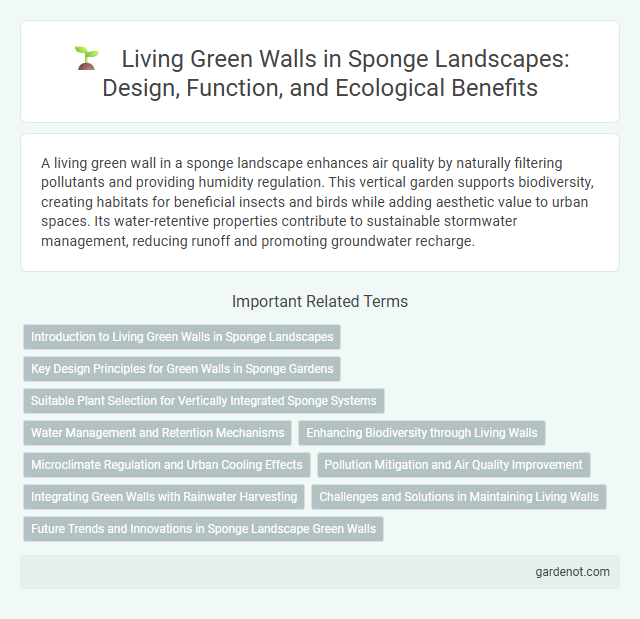A living green wall in a sponge landscape enhances air quality by naturally filtering pollutants and providing humidity regulation. This vertical garden supports biodiversity, creating habitats for beneficial insects and birds while adding aesthetic value to urban spaces. Its water-retentive properties contribute to sustainable stormwater management, reducing runoff and promoting groundwater recharge.
Introduction to Living Green Walls in Sponge Landscapes
Living green walls in sponge landscapes enhance urban resilience by integrating vertical vegetation systems that improve stormwater management and reduce surface runoff. These bio-filtration systems utilize drought-tolerant plant species and porous substrates to absorb rainwater, mitigating flood risks while promoting biodiversity and air quality. Incorporating living green walls supports sustainable urban design by optimizing space usage and providing natural insulation, contributing to energy efficiency and climate adaptation.
Key Design Principles for Green Walls in Sponge Gardens
Living green walls in sponge gardens optimize rainwater absorption and reduce urban heat through strategic plant selection and modular panel systems. Key design principles include using native, drought-tolerant species to enhance biodiversity and improve filtration efficiency. Structural support, irrigation methods, and lightweight substrates ensure durability and maximize water retention for sustainable water management.
Suitable Plant Selection for Vertically Integrated Sponge Systems
Selecting suitable plants for vertically integrated sponge systems requires prioritizing species with high water retention and pollutant absorption capabilities, such as ferns, mosses, and philodendrons. Native, drought-resistant plants with robust root systems enhance the efficiency of green walls by optimizing moisture capture and reducing maintenance needs. Incorporating biodiversity with functional plants supports ecosystem services like air purification, temperature regulation, and habitat provision in urban environments.
Water Management and Retention Mechanisms
Living green walls in sponge landscapes utilize advanced water management systems that capture and retain rainwater efficiently, reducing runoff and promoting natural filtration. These walls employ layers of substrate and specialized plants with high water absorption capacity to enhance retention and slow-release irrigation, optimizing moisture availability. Integrating these water retention mechanisms supports sustainable urban ecosystems by mitigating flooding, improving air quality, and conserving water resources.
Enhancing Biodiversity through Living Walls
Living green walls significantly enhance biodiversity by providing habitat and food sources for various pollinators, birds, and beneficial insects within urban environments. These vertical ecosystems support a diverse range of native plant species that contribute to improved air quality, microclimate regulation, and ecological connectivity. Integrating living walls in sponge landscapes fosters urban resilience by promoting species richness and natural pest control.
Microclimate Regulation and Urban Cooling Effects
Living green walls in sponge landscapes significantly enhance microclimate regulation by reducing ambient temperatures and increasing humidity through evapotranspiration. These vertical gardens contribute to urban cooling effects by mitigating the urban heat island phenomenon, lowering surface temperatures by up to 5degC in densely built areas. Integrating living green walls into urban infrastructure improves air quality and promotes sustainable, energy-efficient city environments.
Pollution Mitigation and Air Quality Improvement
Living green walls in sponge landscapes significantly enhance pollution mitigation by filtering airborne pollutants and absorbing carbon dioxide through dense vegetation layers. These vertical gardens improve air quality by increasing oxygen production and reducing particulate matter, contributing to healthier urban environments. Integrating living green walls promotes biodiversity and supports sustainable urban drainage systems that further reduce air pollution effects.
Integrating Green Walls with Rainwater Harvesting
Integrating living green walls with rainwater harvesting systems enhances urban sustainability by efficiently utilizing captured rainwater to nourish vertical plant installations. This synergy improves stormwater management, reduces runoff pollution, and supports plant health, promoting biodiversity in dense urban environments. Advanced irrigation technology ensures optimal water distribution, maximizing growth while conserving resources, making living green walls a key component of eco-friendly infrastructure.
Challenges and Solutions in Maintaining Living Walls
Maintaining living green walls involves challenges such as ensuring consistent irrigation, preventing pest infestations, and managing nutrient delivery to support plant health. Automated drip irrigation systems combined with moisture sensors optimize water usage and reduce maintenance efforts. Implementing integrated pest management and periodic nutrient monitoring ensures vibrant, sustainable living walls in urban environments.
Future Trends and Innovations in Sponge Landscape Green Walls
Future trends in sponge landscape green walls emphasize integration of advanced bio-filtration systems and smart irrigation technologies to enhance water retention and air purification. Innovations include incorporation of drought-resistant native plant species and modular designs that adapt to urban microclimates, promoting sustainability and biodiversity. Emerging research supports the use of sensor networks for real-time monitoring of moisture levels, enabling optimized maintenance and resource efficiency in green wall management.
Living green wall Infographic

 gardenot.com
gardenot.com